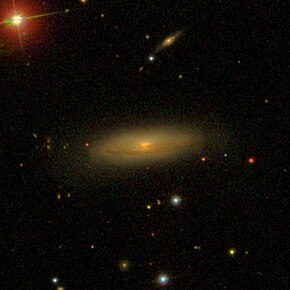| NGC 518 | |
|---|---|
 NGC 518 as seen on
SDSS | |
| Observation data ( J2000 epoch) | |
| Constellation | Pisces [1] |
| Right ascension | 01h 24m 17.7s [1] |
| Declination | +09° 19′ 52″ [1] |
| Redshift | 0.009053 [2] |
| Heliocentric radial velocity | 2702 ± 11 [2] |
| Distance | 122 Mly [3] |
| Apparent magnitude (V) | 13.4 [1] |
| Apparent magnitude (B) | 14.4 [1] |
| Characteristics | |
| Type | Sa [1] |
| Apparent size (V) | 1.6' × 0.6' [1] |
| Other designations | |
| PGC 5161, UGC 952, MCG 1-4-49, ZWG 411.47 [2] | |
NGC 518 is a spiral galaxy located in the Pisces constellation. [1] It was discovered by Albert Marth on 17 December 1864. [4]
See also
References
- ^ a b c d e f g h "Revised NGC Data for NGC 503". spider.seds.org. Retrieved 2017-12-10.
- ^ a b c "NGC 518". SIMBAD. Retrieved 10 August 2014.
- ^ An object's distance from Earth can be determined using Hubble's law: v=Ho is Hubble's constant (70±5 (km/s)/Mpc). The relative uncertainty Δd/d divided by the distance is equal to the sum of the relative uncertainties of the velocity and v=Ho
- ^ "New General Catalog Objects: NGC 500 - 549". cseligman.com. Retrieved 2017-12-10.
External links
-
 Media related to
NGC 518 at Wikimedia Commons
Media related to
NGC 518 at Wikimedia Commons - Deep Sky Browser - NGC518[ permanent dead link]
- Aladin previewer - image
| NGC 518 | |
|---|---|
 NGC 518 as seen on
SDSS | |
| Observation data ( J2000 epoch) | |
| Constellation | Pisces [1] |
| Right ascension | 01h 24m 17.7s [1] |
| Declination | +09° 19′ 52″ [1] |
| Redshift | 0.009053 [2] |
| Heliocentric radial velocity | 2702 ± 11 [2] |
| Distance | 122 Mly [3] |
| Apparent magnitude (V) | 13.4 [1] |
| Apparent magnitude (B) | 14.4 [1] |
| Characteristics | |
| Type | Sa [1] |
| Apparent size (V) | 1.6' × 0.6' [1] |
| Other designations | |
| PGC 5161, UGC 952, MCG 1-4-49, ZWG 411.47 [2] | |
NGC 518 is a spiral galaxy located in the Pisces constellation. [1] It was discovered by Albert Marth on 17 December 1864. [4]
See also
References
- ^ a b c d e f g h "Revised NGC Data for NGC 503". spider.seds.org. Retrieved 2017-12-10.
- ^ a b c "NGC 518". SIMBAD. Retrieved 10 August 2014.
- ^ An object's distance from Earth can be determined using Hubble's law: v=Ho is Hubble's constant (70±5 (km/s)/Mpc). The relative uncertainty Δd/d divided by the distance is equal to the sum of the relative uncertainties of the velocity and v=Ho
- ^ "New General Catalog Objects: NGC 500 - 549". cseligman.com. Retrieved 2017-12-10.
External links
-
 Media related to
NGC 518 at Wikimedia Commons
Media related to
NGC 518 at Wikimedia Commons - Deep Sky Browser - NGC518[ permanent dead link]
- Aladin previewer - image